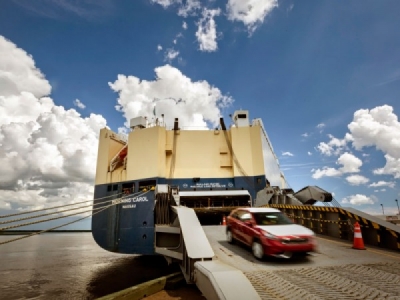
Posted on January 29, 2019
Often overlooked in the shadow of booming Port of Savannah container facilities some 80 miles to the north, the Georgia Ports Authority’s expanding Port of Brunswick is further realizing its potential as a key cog in the GPA’s vertically integrated approach to serving its diverse customer base.
“We haven’t begun to see the capacity and the capability that Brunswick brings to the market, especially in the way of space and growth potential,” Griff Lynch, the GPA’s executive director, told AJOT.
Vehicle volumes continue to rise at the Georgia Ports Authority’s Port of Brunswick.
For example, he pointed out, at the Mayor’s Point Terminal in Brunswick, breakbulk and bulk goods are loaded on ships for export, but, moreover, that terminal also receives via rail and truck domestic containers that are filled with forest products. At Brunswick, the containers are stripped and the contents consolidated in international boxes that are drayed up to Savannah for ocean transport.
“Here again, you have a smaller facility feeding a larger facility in a vertically integrated manner,” Lynch said.
At the Port of Brunswick’s roll-on/roll-off facility – the Colonel’s Island Terminal – Kia is exporting vehicles built at the automaker’s plant in West Point, Georgia, relying heavily upon parts imported across GPA docks. This year’s initiation by Kia of production of its Telluride SUV model is anticipated to add to Brunswick vehicle exports as well as parts imports.
The Brunswick ro/ro operation is growing this year with 60 additional dockside acres, increasing car storage by 8,250 spaces, bringing that total to nearly 100,000, while new cross-terminal and access roadways are being built to better link berths and facilities of multiple auto processors.
Also, Brunswick rail capacity is being doubled, to facilitate building by CSX and Norfolk Southern of 10,000-foot-long unit trains for transporting vehicles as far as California.
By yearend, the GPA looks to have added 250 acres, for a total of 550 acres of leasable space for auto processing at Colonel’s Island. By bringing an additional 400 acres online, the annual throughput capacity at Brunswick is anticipated to nearly double to 1.5 million vehicles a year.
Although not quite so impressive as the double-digit volume increases that have become routine at the Port of Savannah’s container facilities, the Port of Brunswick has been recording month-over-month gains in the range of 8 percent to 9 percent.
“By tonnage, Brunswick is already the second-busiest ro/ro port in the nation, behind only Baltimore,” Lynch said. “As business grows to fill our expanding terminal, the Port of Brunswick will play an even larger role on the global trade in vehicles and heavy equipment.”
Source: AJOT





